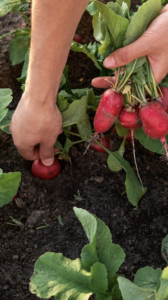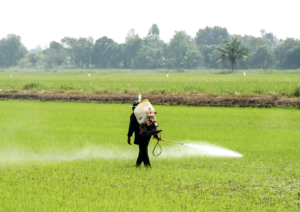Nutrient Decline in Australian Soils Over 20 Years
Key nutrients in Australian soil have been declining over the past 20 years [1]. Also converting native land to intensive agriculture typically reduces soil carbon stocks by 20–60%, which contribute to global warming [2]. If we take nutrients from the soil each time we harvest a crop and we don’t feed our soil with compost and plant matter, the soil quality decreases and so do the nutrient levels.If the soil is depleted, so will the crops that grow in it. Australian soils—already naturally low in fertility—have been further depleted in phosphorus, potassium, and micronutrients such as zinc [3]. In fact, studies indicate that about two-thirds of Australia’s agricultural land is affected by nutrient depletion, acidification, and a decline in soil organic matter [1]. So how nutritious are your vegetables?
Why Are Soil Nutrients Declining?
Modern farming methods remove more nutrients than they replace. When crops are harvested and crop residues are removed, the nutrients in those plants are lost. Without adequate replenishment, the soil’s nutrient levels gradually decline. Continuous cropping, without giving the soil a chance to recover, exacerbates this nutrient mining process [3]. Soil organic matter, which holds and recycles nutrients, also declines under intensive cultivation, leading to poorer soil structure and fertility.
Additionally, heavy reliance on pesticides further contributes to nutrient loss by damaging the soil’s living ecosystem. Healthy soil is full of microbes and invertebrates that help cycle nutrients. However, broad-spectrum pesticides, such as glyphosate and neonicotinoids, can reduce microbial diversity resulting in less effective breakdown of organic matter into plant-available nutrients [4]. Fortunately, Neonicotinoid insecticides were phased out in 2024, but are still used on seed coatings, which can still impact soil health [4].
Healthy Soil Fights Global Warming
Healthy soils are not only important for crop nutrition—they are also a vital part of our planet’s carbon balance. Globally, soils store vast amounts of carbon, with Australian soils holding roughly 23–40 gigatonnes of carbon in the top 30 cm [2]. When soils are degraded, they lose organic matter and release stored carbon as CO₂, contributing to global warming. Agricultural practices that deplete soil carbon—through tillage, removal of crop residues, and erosion—can transform soils from carbon sinks into carbon sources, further fueling climate change [1].
Our vegetables are not as nutritious
The changing nutrient ratios in soils can have a significant impact on the nutritional quality of our food. Lower soil nutrient levels can result in crops with reduced levels of vitamins and minerals. For instance:
- Zinc: Deficiencies can impair immune function. In regions with zinc-poor soils, the concentration of zinc in staple foods can be lower, contributing to suboptimal dietary intake.
- Phosphorus and Potassium: These are crucial for energy metabolism and muscle function, and their decline can affect overall health.
- Micronutrients: Reduced availability of trace elements such as copper and magnesium may contribute to various chronic conditions.
National surveys have revealed concerning statistics. For example, one study reported that nearly 25% of Australian women have inadequate iron intake, and 73% of females do not meet the recommended calcium intake [5]. While multiple factors (including diet quality and food processing) contribute to these deficiencies, declining soil health plays a role by reducing the nutrient density of crops.
What Can You Do?
1. Eat a Nutritious Nutrient-Rich, Diverse Diet
Focus on consuming whole, fresh foods. A varied diet rich in fruits, vegetables, whole grains, lean proteins, and dairy can help counterbalance potential deficits from lower soil nutrient levels. Include foods that are naturally nutrient-dense, such as leafy greens (rich in magnesium and folate), legumes (high in iron), nuts (for zinc), and seafood (for iodine and omega-3 fatty acids) [5]. Diversifying your diet also means you’re less likely to be affected if one nutrient happens to be lower in a specific food source.
2. Choose Vegetables from Sustainable, Soil-Friendly Farms
Support suppliers that use regenerative, organic, or biodynamic farming practices. These methods emphasise crop rotation, cover cropping, composting, and minimal chemical use—all of which help rebuild soil organic matter and improve nutrient cycling. When shopping, look for labels such as “Certified Organic” or “Regenerative Organic Certified.” Farmers’ markets can also be a good source, as you can often speak directly with growers about their methods [3].
3. Improve Soil Health at Home
If you grow your own food, consider these practical tips for nurturing your soil:
- Add Organic Matter: Regularly incorporate compost and support worm communities to improve soil structure and nutrient content.
- Encourage Soil Life: Avoid overusing chemical pesticides. Instead, use organic pest management techniques to protect beneficial soil microbes and invertebrates.
- Crop Rotation and Diversity: Rotate crops and plant cover crops to naturally replenish soil nutrients. This will replace the nutritents in the soil, so that you will grow more nutritious vegetables, herbs and fruits.
4. Book a consultation and have your levels assessed
Unfortunately, we cannot assume that we are getting all of the nutrients we require simply by eating well. Therefore it is important to question any symptoms that you develop and also have regular pathology testing.
Common vague symptoms such as fatigue, thinning hair, dry skin, frequent colds, muscle twitches, headaches or white spots on your nails may indicate nutrient depletion. Many nutrients impact various aspects of our health, so depletion can have wide ranging effects. However, repletion can therefore also cause major health gains.
If you are concerned about a symptom (or symptoms), or haven’t had nutritional testing for many years, consider booking an appointment and take a proactive approach to your long-term health and wellness.
References
- CSIRO Soil Carbon Research: Overview of long-term soil carbon decline in agricultural lands. Link
- Australian Bureau of Statistics & CSIRO Reports: Data on soil organic matter and carbon stocks in Australia. Link
- Soil Science Australia Publications: Studies on nutrient depletion (phosphorus, potassium, micronutrients) in Australian agricultural soils over the past two decades.
- Government and Academic Reports on Pesticide Use: Analysis of glyphosate, neonicotinoids, and chlorpyrifos in Australian agriculture and their effects on soil health.
- National Health Surveys and Nutritional Studies: Statistics on nutrient deficiencies (iron, calcium, zinc) among Australians and their relation to food nutrient density. Link
Want to read more? Here is a great (but very scary) review of the health & environmental impacts of pesticides. There is a fantastic diagram in this article that gives a great summary of all of the diverse impacts on human health that are linked to pesticide exposure. Worth a read! Ahmad MF et al.(2024) Pesticides impacts on human health and the environment with their mechanisms of action and possible countermeasures. Heliyon. 10(7): e29128. https://doi.org/10.1016/j.heliyon.2024.e29128




